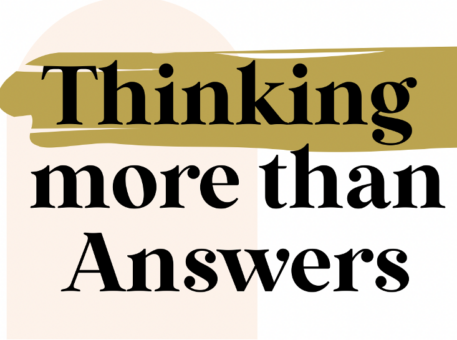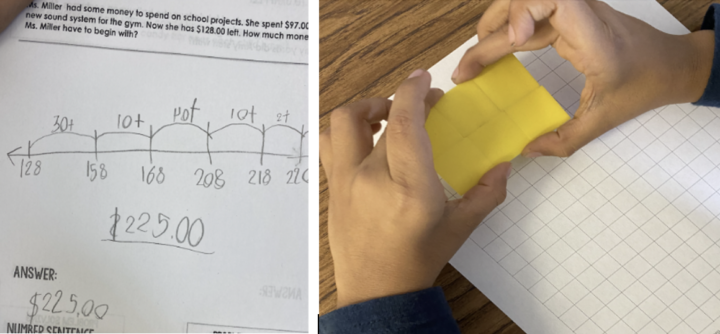How to Teach Students to Grapple with the Math
By Mona Iehl
 I remember the day I first learned what the word grapple meant in the education setting.
I remember the day I first learned what the word grapple meant in the education setting.
I was sitting in a room with my teacher colleagues, working on a 4th grade level math word problem and struggling to find a strategy that could get me the answer.
In a cold sweat, I resisted. I talked to my neighbor, voicing my displeasure with having to do math in our professional development.
I remember saying, “Just tell me what I’m supposed to do with my students.” But as we worked together with our math coach on that 4th grade task I came to understand that we needed to start letting our students productively struggle with the math so they can move beyond risk aversion and fear of failure and build confidence in their ability to grapple with problems and find solutions.
Productive struggle is defined in NCTM’s Principles to Actions this way: “(S)tudents’ struggles are opportunities for developing more deeply into understanding the mathematical structure of problems and relationships among mathematical ideas, instead of simply seeking correct solutions.”
More simply, student struggle is a necessary component of teaching that supports students learning math with understanding and the ability to apply their learning to new problem situations.
Expanding my definition of “helping”
Productive struggle challenged everything I thought I was supposed to be doing as a math teacher. Wasn’t it my job to help my students learn by HELPING them? I questioned how students would ever “get” the math if I didn’t show them what to do. My reaction exposed my own math anxiety caused from years of feeling inadequate in math classes. How could I let my students struggle in good conscience when I knew how it felt to be an outsider in math class?
At the same time, I believed in experiential learning – engaging in experiences and then reflecting on the learning that occurred during that experience. My intermediate classroom was already set up in a way that allowed students to refine their understanding through multiple experiences – in every subject except math.
So I decided to give productive struggle a try in my math lessons.
✦ I committed to letting my students explore the math problem before I gave them any instruction.
✦ I committed to trusting them to use their prior knowledge and previous experiences to find a solution pathway during “grapple time.”
✦ I committed to learning more about how to make math truly experiential.
My students were shocked at first
I’ll never forget the look on my 4th grade students’ faces when I told them what we would be doing. “You want us to do WHAT?” they exclaimed with wide eyes full of with panic and confusion. I reminded them that they were problem solvers during many parts of our day, and today I was giving them a math story to solve.
I instructed them to use everything they knew to approach the problem in any way they wanted. I assured them that their thinking mattered more than their answer. I guaranteed them after they grappled we would discuss their thinking and figure it out together.
Much to my surprise, they went back to their seats and they got out the blocks and drew pictures and tried!! My confidence in grapple time grew and grew as I saw my students build their confidence. Each day they worked on complex problems and built their skills at adjusting problem solving strategies and deepening their mathematical understanding.
Before I knew it, I realized both things could be true: I could HELP my students, but I could also help my students HELP themselves.
There are no shortcuts around struggle
If we commit to productive struggle in our classrooms, then we must rethink our role of “provider of help.” We have to give up the need to fix their ideas and get students to an instant understanding. When we approach math instruction this way, we take away the opportunity for students to develop the essential skills of a mathematician: reasoning, justifying their reasoning, and constructing viable arguments.
Let me give you an example from my own classroom. I’m teaching a math lesson on multiplying fractions (phew! this concept is not easy, right?). I’m at the board presenting the strategy students can use and I see blank stares, but I continue on. I use my checks for understanding and modeling, but nope, still not going well.
In the name of productive struggle, I send the little mathematicians back to their seats to “figure it out,” “give it a try,” and “take a risk.”
Students return to their seats and they are visibly frustrated. Of course there are the two or three that jump in and remember what I showed them, so they get busy reproducing my models with their new numbers. However, many other students are whispering, looking around, sharpening pencils, messing with their binders.
I walk around saying encouraging words and reminding them to just get something down with only a few minutes left on the Grapple Clock. This continues…but it’s mostly blank papers and frustrated looks.
I realize this is not working. So I call their attention to the board, and I break it down step by step, walking them through it. I have them do the problem on their paper as I do it on the board. Slowly the smiles come back and soon they are nodding along with me. Most students are with me and feeling better. I’ve accomplished my mission… to ensure every child loves math and feels success, right?
EKKKK! But wait a minute… That example from my classroom is not actually productive struggle.
During that lesson I got uncomfortable watching my students struggle so I jumped in and broke down the task and guided students through the solution step by step. My teacher moves undermined the students’ effort and took away their opportunity to do the cognitively demanding work of problem solving. I communicated to my students that because they didn’t understand, they needed to follow my steps. I inadvertently lowered their confidence and lowered the bar.
The question then becomes “how do we build our students’ confidence to even try when things get tough in math class?” The reality is that math class is hard for many students, and lots of students come to math class lacking the prior knowledge to problem solve.
Oftentimes we are compelled to analyze what students don’t know and then fill holes in student understanding. However, in order to build confidence, we must start with what students do know.
Students’ confidence is built when they are given opportunities to be successful. When we measure success based on participation, effort, and thinking, students can recognize the power they hold over their strengths and capabilities.
Just how do we build student confidence?
Let me give you an example from my primary teaching days. I gave my first graders this task, “There are 3 baskets on the playground and each basket has 5 jump ropes in it. How many jump ropes are in the baskets on the playground?”
My students’ confidence is built when they are able to work through that problem independently during grapple time and then discuss their thinking during our math discourse.
Students see that they can solve this complex problem by using their own thinking, tools, and reasoning. Then students explain how they solved it to a friend and help them understand. This allows students to see themselves as capable of doing math because they can not only solve it, but explain it to others.
So now the next time a student goes to solve a complex word problem they will remember… “I solved that jump rope problem and it was really hard. I can do this one, too.”
Confidence is built through productive struggle.
Here are four steps to consider as you’re starting down the path of incorporating productive struggle into your math classroom. I use the simple acronym PATH to remember the steps.
P: Provide Support
Productive struggle doesn’t mean there isn’t support. It just has to be the right kind of support. Developing a safe and supportive classroom environment is the best way to support students in taking risks in their thinking and problem solving. You can start by creating a predictable routine so that students come to expect to productively struggle each day.
A: Ask Questions to Support
A simple shift in our teacher practice from telling to asking can support your students without removing the challenge and allow them to continue to productively struggle. Consider asking questions when students are stuck. (See more about effective questioning here.)
If you happen upon a student who is frustrated and blank-staring you during grapple time, try asking, “Can you show me what you’re up to?” If they’re still stuck, you might say, “Let’s re-read the problem” and then, “What is happening in the problem?” These questions prompt students to share their reasoning while directing them back to the problem to find information instead of relying on you.
T: Tasks that Allow for Problem Solving
Knowing your students’ strengths and areas of need are essential when choosing a task that allows for problem solving while also building mathematical skills and understanding. Choose a problem that is in your student’s zone of proximal development – proximal meaning the student is close to mastering the skill so that the task is not too hard nor too easy. (See more about choosing math tasks here.)
H: Have Confidence
Express confidence in your students’ ability to problem solve without your step by step guidance, and watch them impress you!! So much of what we must do is get our teacher mindset straight. Oftentimes that means looking at our students and instruction in a slightly different way. I encourage you to get to your students’ strengths and start from there. It will not only build your students’ confidence, but you’ll see all the things they are capable of doing! (See my thoughts about strengths and assets here.)
Shifting Our Support
For too long we’ve worried about helping students overcome challenges and get to that feeling of success as quickly as possible. Our students are the innovators of the future. We don’t need human calculators – calculators have already been invented. Instead, we have to support our students in learning what it means to work through a challenge, come up with nothing, and then try something else.
We have to help our students confront failure with a mindset and attitude of gratitude for the opportunity to learn. We can guide our students in building their confidence through refining their understanding by way of solving problems. (Read more about creating a culture of problem-solving here.)
As Carol Dweck has said, “[F]or the last few decades many parents and educators have been more interested in making students feel good about themselves in math and science than in helping them achieve.”
Let’s change that today by including productive struggle as the way our students build confidence in math.
Mona Iehl (@HelloMonaMath) has been a fifth- and sixth-grade math teacher in Chicago, Illinois for six years. She started her 14-year year teaching career in the primary grades but found her home in the middle grades. This fall she has taken on the role of coach. For more details about her teaching methods, visit her website and see her other MiddleWeb posts here.
Mona recently took her passion for helping teachers and students find their inner mathematician to a podcast. Listen in at @HonestMathChat. More fluency resources for multiplication and division systems are available at her Mona Math TPT shop.





































I am currently setting my students up to start working on the “Building Thinking Classrooms” model in class. So far, I’ve used somewhat easier problems than my typical students could “get,” but when my atypical students figured out strategies to solve these problems, they were excited and wanted to do more math! My biggest fear is not finding enough “problems” for 4th graders that will help them struggle productively.
Hi Liz,
The trick to productive struggle is to find the right task that has an easy first step, but has enough ways to challenge students. Finding tasks is a challenge… but don’t over complicate it. I bet the curriculum you use has tasks that would be great for productive struggle. In 4th grade it might be a task about fraction comparison and beginning calculations… “Terrell has 1/3 of a cake and his sister has 3/6. Who has more? How much more? Prove your thinking with drawings, numbers, and words.”
Look at the end of your lessons for the word problems that are “application” or “critical thinking”. These are often left till the end and skipped, but are perfect to start with… have students productively struggle with and then facilitate a math discussion that helps them understand the problem and solution pathways better!
If you want to chat about more tasks you’re welcome to send me an email and I can share some more ideas.
Hope this helps!
Mona